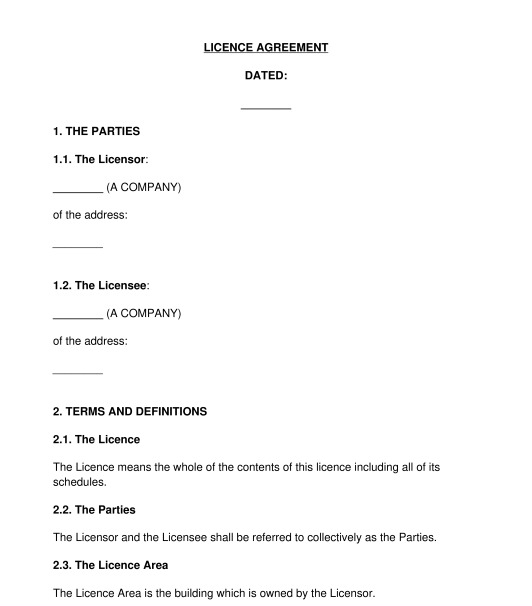 31/10/2025
31/10/2025

Answer a few questions and your document is created automatically.

Your document is ready! You will receive it in Word and PDF formats. You will be able to modify it.

 31/10/2025
31/10/2025
 Word and PDF
Word and PDF
 6 to 8 pages
6 to 8 pages
A business licence to occupy is a legal agreement that permits one party (a licensee) to use certain parts of a property owner's (the licensor's) land/building. A licence is used where the parties do not want to create a formal lease agreement. This licence to occupy is designed for use where the rented property is based in England and Wales. The licence is a business licence and therefore the property should be used by the licensee for a commercial purpose under the agreement.
This licence can be adjusted to suit the specific circumstances of the licensor and licensee. Examples where an agreement of this nature may be used include shopping centres with different kiosks or office spaces where hot-desking takes place. Specific licences are available for:
A licence is an agreement that permits a person or legal entity to do something. A licence will grant permission to a party to occupy a space or part of a property but does not grant a legal interest in the property.
A business tenant under a tenancy agreement will be allowed to occupy the property exclusively (i.e. the landlord will not be permitted to occupy the property at the same time). A business licensee will only have the right to use a space or room, and the licensor will retain the right to occupy that space at all times. A licence will only last for a short period (commonly 6 months).
In contrast, a business tenant will have particular rights and obligations under a tenancy agreement including, in most circumstances, a right to renew the lease at the end of the term.
No. It is possible to grant a business the authority to use a space in a building informally (verbally). However, it is helpful to have a written agreement so that each party is certain of the terms of the agreement.
The licensee should not be granted exclusive possession over the whole of the licensor's property. The licence agreement will specifically state that the licensor may change the defined area which the licensor may use, in order to address this. That is because exclusive possession is a key feature of a tenancy agreement.
Before a licensor grants a licence, they should:
The licensor may be a natural person, in which case they should:
The licensor can also be a corporate entity (such as a company or a LLP).
The licensee must be a business – whether a sole trader or a corporate entity.
A residential tenant or residential lodger should not use this licence to occupy.
A business licensee will usually only last for a short period. Commonly this will be for 6 months. The agreement can also make a provision for the parties to terminate the licence early, by giving written notice.
Each party should retain a signed copy of the licence. There is no requirement for the agreement to be witnessed or notarised. It is also not necessary to register the document once it has been signed.
The agreement is not reviewed by a lawyer to ensure that the legal content applies to the personal situation of the parties. In order to review the particulars of the agreement, it will be necessary to instruct a lawyer. For this type of agreement, it will be necessary to consult with a lawyer who is regulated by an approved regulator in the legal services sector. It is possible to search for a lawyer using the Law Society find a solicitor page in England and Wales.
The following documents may be attached to a licence to occupy:
It is possible to read more about what a schedule of condition involves on the government website.
If one party breaches the terms of an agreement the other party may wish to:
The licence to occupy should:
Some of the key provisions which are relevant in determining the distinctions between leases and licences are:
You fill out a form. The document is created before your eyes as you respond to the questions.
At the end, you receive it in Word and PDF formats. You can modify it and reuse it.
A guide to help you: Signing Documents in England and Wales
Business Licence to Occupy - Template - Word & PDF
Country: United Kingdom